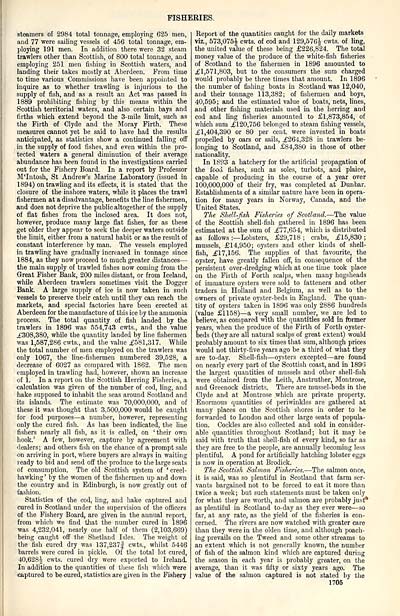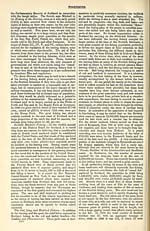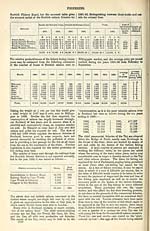Ordnance gazetteer of Scotland
(1713) Page 1705
Download files
Complete book:
Individual page:
Thumbnail gallery: Grid view | List view

FISHERIES.
steamers of 2984 total tonnage, employing 625 men,
and 77 were sailing vessels of 456 total tonnage, em-
ploying 191 men. In addition there were 32 steam
trawlers other than Scottish, of 800 total tonnage, and
employing 251 men fishing in Scottish waters, and
landing their takes mostly at Aberdeen. From time
to time various Commissions have been appointed to
inquire as to whether trawling is injurious to the
supply of fish, and as a result an Act was passed in
1889 prohibiting fishing by this means within the
Scottish territorial waters, and also certain bays and
firths which extend beyond the 3-mile limit, such as
the Firth of Clyde and the Moray Firth. These
measures cannot yet be said to have had the results
anticipated, as statistics show a continued falling off
in the supply of food fishes, and even within the pro-
tected waters a general diminution of their average
abundance has been found in the investigations carried
out for the Fishery Board. In a report by Professor
M'Intosh, St Andrew's Marine Laboratory (issued in
1894) on trawling and its effects, it is stated that the
closure of the inshore waters, while it places the trawl
fishermen at a disadvantage, benefits the line fishermen,
and does not deprive the public altogether of the supply
of fiat fishes from the inclosed area. It does not,
however, produce many large flat fishes, for as these
get older they appear to seek the deeper waters outside
the limit, either from a natural habit or as the result of
constant interference by man. The vessels employed
in trawling have gradually increased in tonnage since
1884, as they now proceed to much greater distances —
the main supply of trawled fishes now coming from the
Great Fisher Bank, 200 miles distant, or from Iceland,
while Aberdeen trawlers sometimes visit the Dogger
Bank. A large supply of ice is now taken in such
vessels to preserve their catch until they can reach the
markets, and special factories have been erected at
Aberdeen for the manufacture of this ice by the ammonia
process. The total quantity of fish landed by the
trawlers in 1896 was 554,743 cwts., and the value
£308,380, while the quantity landed by line fishermen
was 1,587,286 cwts., and the value £581,317. While
the total number of men employed on the trawlers was
only 1067, the line-fishermen numbered 39,528, a
decrease of 6027 as compared with 1862. The men
employed in trawling had, however, shown an increase
of 1. In a report on the Scottish Herring Fisheries, a
calculation was given of the number of cod, ling, and
hake supposed to inhabit the seas around Scotland and
its islands. The estimate was 70,000,000, and of
these it was thought that 3,500,000 would be caught
for food purposes — a number, however, representing
only the cured fish. As has been indicated, the line
fishers nearly all fish, as it is called, on 'their own
hook.' A few, however, capture by agreement with
dealers; and others fish on the chance of a prompt sale
•on arriving in port, where buyers are always in waiting
ready to bid and send off the produce to the large seats
of consumption. The old Scottish system of ' creel-
hawking ' by the women of the fishermen up and down
the country and in Edinburgh, is now greatly out of
fashion.
Statistics of the cod, ling, and hake captured and
cured in Scotland under the supervision of the officers
of the Fishery Board, are given in the annual report
from which we find that the number cured in 1896
was 4,232,041, nearly one half of them (2,103,669)
being caught off the Shetland Isles. The weight of
the fish cured dry was 137,237| cwts., whilst 5446
barrels were cured in pickle. Of the total lot cured,
40,628$ cwts. cured dry were exported to Ireland.
In addition to the quantities of these fish which were
captured to beoured, statistics are given in the Fishery
Report of the quantities caught for the daily markets
viz., 573,075$ cwts. of cod and 129,576$ cwts. of ling,
the united value of these being £226,824. The total
money value of the produce of the white-fish fisheries
of Scotland to the fishermen in 1896 amounted to
£1,571,803, but to the consumers the sum charged
would probably be three times that amount. In 1896
the number of fishing boats in Scotland was 12,040,
and their tonnage 113,382; of fishermen and boys,
40,595; and the estimated value of boats, nets, lines,
and other fishing materials used in the herring and
cod and ling fisheries amounted to £1,873,854, of
which sum £120,756 belonged to steam fishing vessels,
£1,404,390 or 80 per cent, were invested in boats
propelled by oars or sails, £264,328 in trawlers be-
longing to Scotland, and £84,380 in those of other
nationality.
In 1893 a hatchery for the artificial propagation of
the food fishes, such as soles, turbots, and plaice,
capable of producing in the course of a year over
100,000,000 of their fry, was completed at Dunbar.
Establishments of a similar nature have been in opera-
tion for many years in Norway, Canada, and the
United States.
The Shell-fish Fisheries of Scotland. — The value
of the Scottish shell-fish gathered in 1896 has been
estimated at the sum of £77,654, which is distributed
as follows :— Lobsters, £29,718 ; crabs, £15,830 ;
mussels, £14,950; oysters and other kinds of shell-
fish, £17,156. The supplies of that favourite, the
oyster, have greatly fallen off, in consequence of the
persistent over-dredging which at one time took place
on the Firth of Forth scalps, when many hogsheads
of immature oysters were sold to fatteners and other
traders in Holland and Belgium, as well as to the
owners of private oyster-beds in England. The quan-
tity of oysters taken in 1896 was only 2886 hundreds
(value £1158) — a verv small number, we are led to
believe, as compared with the quantities sold in former
years, when the produce of the Firth of Forth oyster-
beds (they are all natural scalps of great extent) would
probably amount to six times that sum, although prices
would not thirty-five years ago be a third of what they
are to-day. Shell-fish — oysters excepted — are found
on nearly every part of the Scottish coast, and in 1896
the largest quantities of mussels and other shell-fish
were obtained from the Leith, Anstruther, Montrose,
and Greenock districts. There are mussel-beds in the
Clyde and at Montrose which are private property.
Enormous quantities of periwinkles are gathered at
many places on the Scottish shores in order to be
forwarded to London and other large seats of popula-
tion. Cockles are also collected and sold in consider-
able quantities throughout Scotland; but it may be
said with truth that shell-fish of every kind, so far as
they are free to the people, are annually becoming less
plentiful. A pond for artificially hatching lobster eggs
is now in operation at Brodick.
The Scottish Salmon Fisheries. — The salmon once,
it is said, was so plentiful in Scotland that farm ser-
vants bargained not to be forced to eat it more than
twice a week; but such statements must be taken only
for what they are worth, and salmon are probably just*
as plentiful in Scotland to-day as they ever were — so
far, at any rate, as the yield of the fisheries is con-
cerned. The rivers are now watched with greater care
than they were in the olden time, and although poach-
ing prevails on the Tweed and some other streams to
an extent which is not generally known, the number
of fish of the salmon kind which are captured during
the season in each year is probably greater, on the
average, than it was fifty or sixty years ago. The
value of the salmon captured is not stated by the
1705
steamers of 2984 total tonnage, employing 625 men,
and 77 were sailing vessels of 456 total tonnage, em-
ploying 191 men. In addition there were 32 steam
trawlers other than Scottish, of 800 total tonnage, and
employing 251 men fishing in Scottish waters, and
landing their takes mostly at Aberdeen. From time
to time various Commissions have been appointed to
inquire as to whether trawling is injurious to the
supply of fish, and as a result an Act was passed in
1889 prohibiting fishing by this means within the
Scottish territorial waters, and also certain bays and
firths which extend beyond the 3-mile limit, such as
the Firth of Clyde and the Moray Firth. These
measures cannot yet be said to have had the results
anticipated, as statistics show a continued falling off
in the supply of food fishes, and even within the pro-
tected waters a general diminution of their average
abundance has been found in the investigations carried
out for the Fishery Board. In a report by Professor
M'Intosh, St Andrew's Marine Laboratory (issued in
1894) on trawling and its effects, it is stated that the
closure of the inshore waters, while it places the trawl
fishermen at a disadvantage, benefits the line fishermen,
and does not deprive the public altogether of the supply
of fiat fishes from the inclosed area. It does not,
however, produce many large flat fishes, for as these
get older they appear to seek the deeper waters outside
the limit, either from a natural habit or as the result of
constant interference by man. The vessels employed
in trawling have gradually increased in tonnage since
1884, as they now proceed to much greater distances —
the main supply of trawled fishes now coming from the
Great Fisher Bank, 200 miles distant, or from Iceland,
while Aberdeen trawlers sometimes visit the Dogger
Bank. A large supply of ice is now taken in such
vessels to preserve their catch until they can reach the
markets, and special factories have been erected at
Aberdeen for the manufacture of this ice by the ammonia
process. The total quantity of fish landed by the
trawlers in 1896 was 554,743 cwts., and the value
£308,380, while the quantity landed by line fishermen
was 1,587,286 cwts., and the value £581,317. While
the total number of men employed on the trawlers was
only 1067, the line-fishermen numbered 39,528, a
decrease of 6027 as compared with 1862. The men
employed in trawling had, however, shown an increase
of 1. In a report on the Scottish Herring Fisheries, a
calculation was given of the number of cod, ling, and
hake supposed to inhabit the seas around Scotland and
its islands. The estimate was 70,000,000, and of
these it was thought that 3,500,000 would be caught
for food purposes — a number, however, representing
only the cured fish. As has been indicated, the line
fishers nearly all fish, as it is called, on 'their own
hook.' A few, however, capture by agreement with
dealers; and others fish on the chance of a prompt sale
•on arriving in port, where buyers are always in waiting
ready to bid and send off the produce to the large seats
of consumption. The old Scottish system of ' creel-
hawking ' by the women of the fishermen up and down
the country and in Edinburgh, is now greatly out of
fashion.
Statistics of the cod, ling, and hake captured and
cured in Scotland under the supervision of the officers
of the Fishery Board, are given in the annual report
from which we find that the number cured in 1896
was 4,232,041, nearly one half of them (2,103,669)
being caught off the Shetland Isles. The weight of
the fish cured dry was 137,237| cwts., whilst 5446
barrels were cured in pickle. Of the total lot cured,
40,628$ cwts. cured dry were exported to Ireland.
In addition to the quantities of these fish which were
captured to beoured, statistics are given in the Fishery
Report of the quantities caught for the daily markets
viz., 573,075$ cwts. of cod and 129,576$ cwts. of ling,
the united value of these being £226,824. The total
money value of the produce of the white-fish fisheries
of Scotland to the fishermen in 1896 amounted to
£1,571,803, but to the consumers the sum charged
would probably be three times that amount. In 1896
the number of fishing boats in Scotland was 12,040,
and their tonnage 113,382; of fishermen and boys,
40,595; and the estimated value of boats, nets, lines,
and other fishing materials used in the herring and
cod and ling fisheries amounted to £1,873,854, of
which sum £120,756 belonged to steam fishing vessels,
£1,404,390 or 80 per cent, were invested in boats
propelled by oars or sails, £264,328 in trawlers be-
longing to Scotland, and £84,380 in those of other
nationality.
In 1893 a hatchery for the artificial propagation of
the food fishes, such as soles, turbots, and plaice,
capable of producing in the course of a year over
100,000,000 of their fry, was completed at Dunbar.
Establishments of a similar nature have been in opera-
tion for many years in Norway, Canada, and the
United States.
The Shell-fish Fisheries of Scotland. — The value
of the Scottish shell-fish gathered in 1896 has been
estimated at the sum of £77,654, which is distributed
as follows :— Lobsters, £29,718 ; crabs, £15,830 ;
mussels, £14,950; oysters and other kinds of shell-
fish, £17,156. The supplies of that favourite, the
oyster, have greatly fallen off, in consequence of the
persistent over-dredging which at one time took place
on the Firth of Forth scalps, when many hogsheads
of immature oysters were sold to fatteners and other
traders in Holland and Belgium, as well as to the
owners of private oyster-beds in England. The quan-
tity of oysters taken in 1896 was only 2886 hundreds
(value £1158) — a verv small number, we are led to
believe, as compared with the quantities sold in former
years, when the produce of the Firth of Forth oyster-
beds (they are all natural scalps of great extent) would
probably amount to six times that sum, although prices
would not thirty-five years ago be a third of what they
are to-day. Shell-fish — oysters excepted — are found
on nearly every part of the Scottish coast, and in 1896
the largest quantities of mussels and other shell-fish
were obtained from the Leith, Anstruther, Montrose,
and Greenock districts. There are mussel-beds in the
Clyde and at Montrose which are private property.
Enormous quantities of periwinkles are gathered at
many places on the Scottish shores in order to be
forwarded to London and other large seats of popula-
tion. Cockles are also collected and sold in consider-
able quantities throughout Scotland; but it may be
said with truth that shell-fish of every kind, so far as
they are free to the people, are annually becoming less
plentiful. A pond for artificially hatching lobster eggs
is now in operation at Brodick.
The Scottish Salmon Fisheries. — The salmon once,
it is said, was so plentiful in Scotland that farm ser-
vants bargained not to be forced to eat it more than
twice a week; but such statements must be taken only
for what they are worth, and salmon are probably just*
as plentiful in Scotland to-day as they ever were — so
far, at any rate, as the yield of the fisheries is con-
cerned. The rivers are now watched with greater care
than they were in the olden time, and although poach-
ing prevails on the Tweed and some other streams to
an extent which is not generally known, the number
of fish of the salmon kind which are captured during
the season in each year is probably greater, on the
average, than it was fifty or sixty years ago. The
value of the salmon captured is not stated by the
1705
Set display mode to: Large image | Transcription
Images and transcriptions on this page, including medium image downloads, may be used under the Creative Commons Attribution 4.0 International Licence unless otherwise stated. ![]()
| Gazetteers of Scotland, 1803-1901 > Ordnance gazetteer of Scotland > (1713) Page 1705 |
|---|
| Permanent URL | https://digital.nls.uk/97413802 |
|---|

